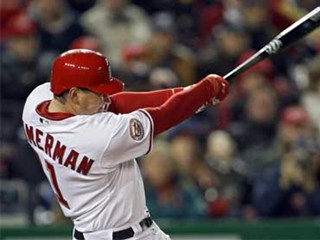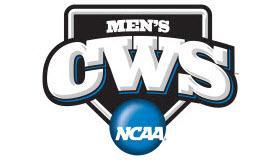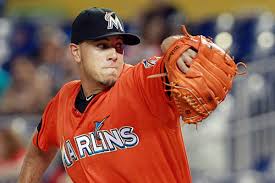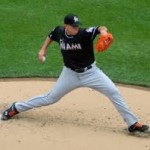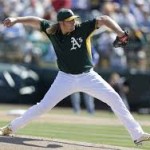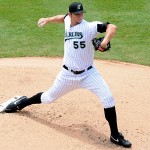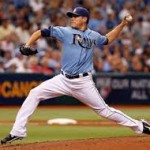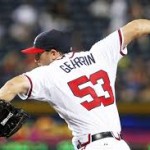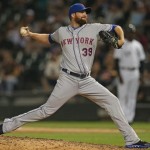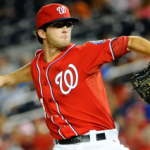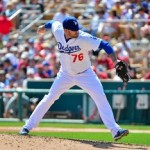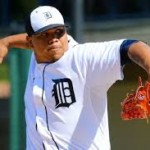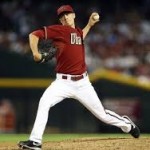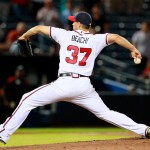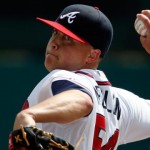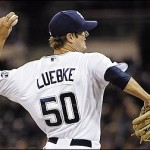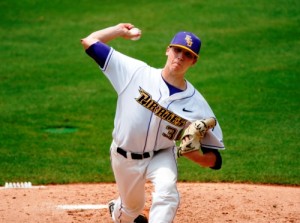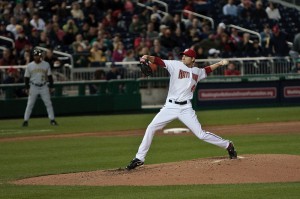… do you just go ahead and start fielding the lineup that we’ll be trotting out in 2015 anyway?
Leave Rendon at 3rd, leave Espinosa at 2nd, install Zimmerman at 1st and trade Adam LaRoche to a team that needs a first baseman?
Perhaps a couple weeks into the season you could have made that argument. But there’s a few problems with this scenario:
- LaRoche is easily the team’s best hitter right now with a slash line better than the coveted .300/.400/.500. You don’t trade the best hitter off of your offensively struggling team.
- Nobody makes trades 8 weeks into the season. And most of the possible trade candidates for LaRoche (Baltimore, New York, Milwaukee, Pittsburgh) don’t make as much sense now as they may have a few weeks ago.
- Espinosa is starting to remind the team again why they demoted him last year, with his average now slipping towards Mendoza line territory.
- Despite the Nats awful stretch, they’re only 2.5 games out of first in the NL East, and that’s during a stretch when the meat of their order has been missing. Its far too early to wave any white flags and/or start dismantling the team.
I’m sure part of LaRoche would love to get traded; it frees him of any qualifying offer complication this coming off-season, where at age 34 he’s likely looking at his last final grasp at a multi-year deal. But the other part of LaRoche wants to stick with a winner, a team that gives him the best shot at getting back to the post-season (he’s only got a handful of games in his 11 year career playing in October). On the other hand … the Nats would be crazy to give LaRoche a Q.O., so maybe the team is thinking, “hey, we need to move LaRoche and get *something* for him before we let him walk and get nothing for him.”
More likely the team is actually thinking this: “We were good enough to win last year, we’re good enough to win this year … so we’re keeping the band together until the bitter end, division title or not.”
Or, do you take interest in the fact that Zimmerman has been taking a ton of fly-balls and stick him in left? I like this move: Zimmerman comes back, and you leave the infield as-is, stick him in left field and you’re a stronger lineup. Zimmerman’s “yips” will disappear in Left Field; every throw he’ll make will either be a lob back into the infield after a single, or a max-effort peg to either 2nd or home that won’t allow him time to “think” about the throw. Jon Heyman is now reporting that Zimmerman is being set-up to be a multi-positional player and his fly ball workouts were not (as Zimmerman claimed multiple times) just a “workout” routine.
(side note: I now exactly what Zimmerman is going through; as a 15-yr old middle infielder I tore my rotator cuff. After rehab, I returned and found that I struggled to make simple throws from second base or short stop. I had the yips myself. I eventually moved into the outfield to finish off my career in a rather frustrating fashion. After years of playing softball in my 20s, where nearly every infield throw is max-effort, I had regained a ton of my confidence and could return to playing middle infield on the diamond … but I still struggle on specific plays. When I first came back I caught … and (like Sasser) struggled making the throw back to the pitcher sometimes. Making a double-play turning toss from ss->2nd? I sieze up every time and have resorted to flipping the ball under-handed. It is a very frustrating situation to deal with. Zimmerman acknowleding his issue and trying to do what’s best for the team by limiting his arm exposure shows great character).
Of course, then, when Harper comes back … what do you do?
Maybe you frigging finally sit Denard Span and his middling OBP (which was raised 40 points by his recent outburst and 4-4 game) and stick Harper in center. I’ve had it with our lead-off hitter making outs nearly 8 out of 10 times up. Yes Span is a plus defender in center and inarguably saves runs. No, Harper would not be as good as Span in the field. But at this point, replacing Harper’s production for Span’s in the lineup makes this a better team.
In reality, if Espinosa is still hitting in the low .200s and everyone’s coming back, then he’ll be the one that makes way. I don’t think I like Zimmerman for 2nd base like other pundits do. For one, the guy’s too big for 2nd and I don’t think he’s mobile enough to play that position at this point in his career. But mainly, if he’s got a hitch in his throw from 3rd, he’ll have it even worse from 2nd, where a ton of throws are very casual/toss it over throws and you can go completely mental. There’s a reason that the famous cases of “baseball yips” are either 2nd basemen (Steve Sax, Chuck Knoblock) and catchers (Mackey Sasser). These two positions make a lot of unpressured throws, and guys can get “yippy.”
So that means Rendon back to 2nd, Zimmerman back to 3rd, and the fanbase back to holding its collective breath everytime he gets a grounder. At least until spring training 2015, when this all goes away by itself when LaRoche hits free agency and Zimmerman permanently attaches a 1st basemen’s glove to his left hand.
I’ll give credit where credit is due though on Zimmerman taking fly-balls and apparently being amenable to trying out the outfield: seeing a gold-glove winning veteran on a 9-figure deal trying a new position mid-career, perhaps acknowledging that he has a problem is refreshing. Remember the nightmare we had with Alfonso Soriano moving to left field? And word came out recently that Rickie Weeks “refused to consider” a position switch from 2nd to left, a rather disappointing turn of events for his team, who are paying the underperforming infielder $11M to ride the pine this year. Instead Zimmerman looks to be doing the team-first thing, working out at a new position where he can get back into the lineup AND not hurt the team anymore. It isn’t unheard of for hall-of-fame calibre players to move positions (see Yount, Robin), nor is it unheard of to see plus-defenders try alternate positions for the betterment of the team (see the likes of Manny Machado and Jurickson Profar, both fantastic fielding shortstops who are playing other positions to allow entrenched veterans who may not necessarily be better fielders stay at short). Heck, look at what Rendon did; he was a third baseman all the way … and he made the move to 2nd and has done reasonably well there.
We’ll see what happens when Zimmerman gets off the d/l.
